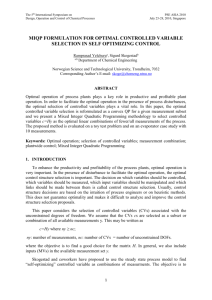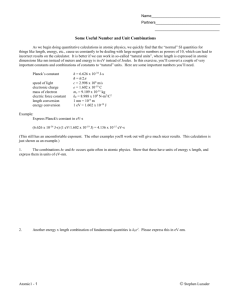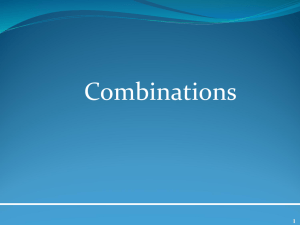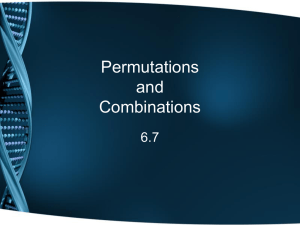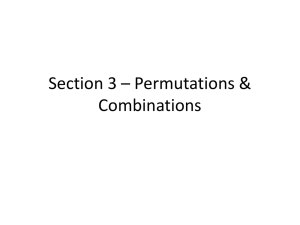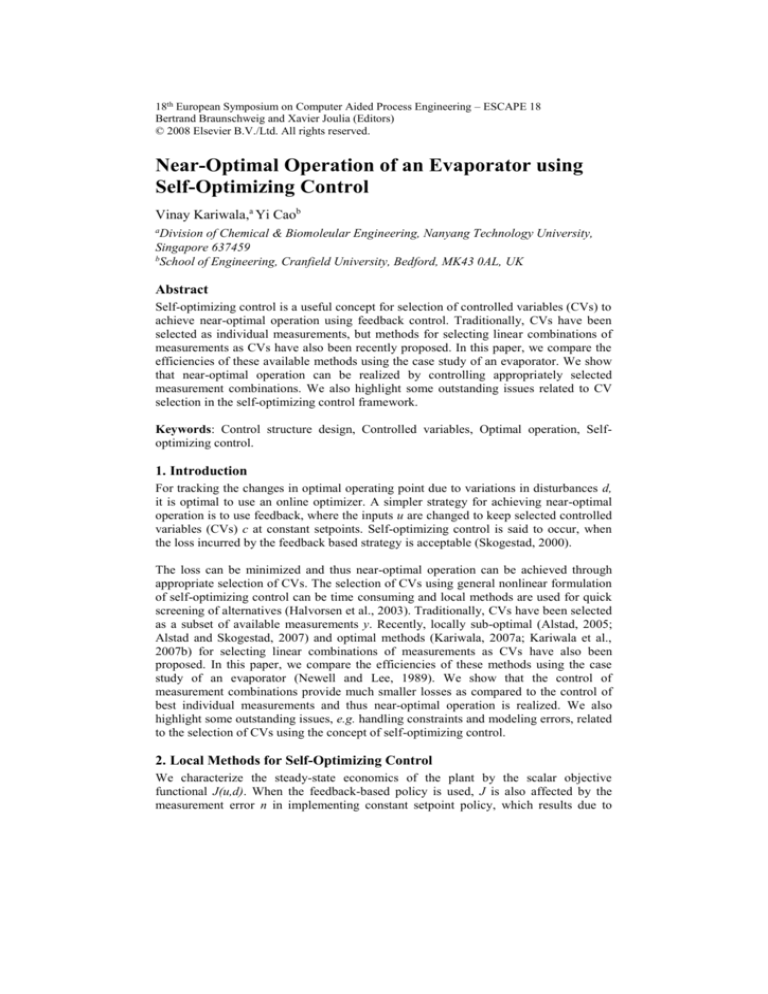
18th European Symposium on Computer Aided Process Engineering – ESCAPE 18
Bertrand Braunschweig and Xavier Joulia (Editors)
© 2008 Elsevier B.V./Ltd. All rights reserved.
Near-Optimal Operation of an Evaporator using
Self-Optimizing Control
Vinay Kariwala,a Yi Caob
a
Division of Chemical & Biomoleular Engineering, Nanyang Technology University,
Singapore 637459
b
School of Engineering, Cranfield University, Bedford, MK43 0AL, UK
Abstract
Self-optimizing control is a useful concept for selection of controlled variables (CVs) to
achieve near-optimal operation using feedback control. Traditionally, CVs have been
selected as individual measurements, but methods for selecting linear combinations of
measurements as CVs have also been recently proposed. In this paper, we compare the
efficiencies of these available methods using the case study of an evaporator. We show
that near-optimal operation can be realized by controlling appropriately selected
measurement combinations. We also highlight some outstanding issues related to CV
selection in the self-optimizing control framework.
Keywords: Control structure design, Controlled variables, Optimal operation, Selfoptimizing control.
1. Introduction
For tracking the changes in optimal operating point due to variations in disturbances d,
it is optimal to use an online optimizer. A simpler strategy for achieving near-optimal
operation is to use feedback, where the inputs u are changed to keep selected controlled
variables (CVs) c at constant setpoints. Self-optimizing control is said to occur, when
the loss incurred by the feedback based strategy is acceptable (Skogestad, 2000).
The loss can be minimized and thus near-optimal operation can be achieved through
appropriate selection of CVs. The selection of CVs using general nonlinear formulation
of self-optimizing control can be time consuming and local methods are used for quick
screening of alternatives (Halvorsen et al., 2003). Traditionally, CVs have been selected
as a subset of available measurements y. Recently, locally sub-optimal (Alstad, 2005;
Alstad and Skogestad, 2007) and optimal methods (Kariwala, 2007a; Kariwala et al.,
2007b) for selecting linear combinations of measurements as CVs have also been
proposed. In this paper, we compare the efficiencies of these methods using the case
study of an evaporator (Newell and Lee, 1989). We show that the control of
measurement combinations provide much smaller losses as compared to the control of
best individual measurements and thus near-optimal operation is realized. We also
highlight some outstanding issues, e.g. handling constraints and modeling errors, related
to the selection of CVs using the concept of self-optimizing control.
2. Local Methods for Self-Optimizing Control
We characterize the steady-state economics of the plant by the scalar objective
functional J(u,d). When the feedback-based policy is used, J is also affected by the
measurement error n in implementing constant setpoint policy, which results due to
2
Kariwala and Cao
measurement noise and other uncertainties. To account for n, the linearized model of the
process, obtained around the nominally optimal operating point, is represented as
y G y u GdyWd d Wn n
(1)
where the diagonal matrices Wd and Wn contain the magnitudes of expected disturbances
and implementation errors associated with the individual measurements, respectively. In
(1), y, u, d and n are ny, nu, nd and ny dimensional vectors, respectively, where ny ≥ nu.
The CVs, c are given as
c Hy Gu GdWd d HWn n
(2)
where G = HGy and Gd HG dy . When d and n are constrained to satisfy ||[dT nT]T||2 ≤ 1,
the worst-case and average losses are (Halvorsen et al., 2003; Kariwala et al., 2007)
1 2
M d M n
Lworst max
2
1
M d M n 2F
Laverage
6(n y nd )
(3)
where σmax(.) is the maximum singular value, ||.||F is the Frobenius norm,
1/ 2
J uu1 J ud G 1Gd Wd and M n J uu1/ 2G 1HWn . Here, Juu = ∂2J/∂u2 and Jud =
M d J uu
∂2J/(∂u∂d), evaluated at nominally optimal operating point.
The CVs are selected by minimizing the losses in (3) with respect to H. When
individual measurements are selected as CVs, the best nu measurements are selected by
restricting the elements of H to be 0 or 1 and enforcing HHT = I. When combinations of
measurements are used as CVs, the integer restriction on the elements of H is relaxed
but the additional condition rank(H) = nu is imposed. Halvorsen et. al (2003) used nonlinear optimization for finding H, which can be very time consuming and more
importantly can converge to local optima. Alstad and Skogestad (2007) proposed the
use of null space method, where the implementation error is ignored and H is selected
such that.
1
H G y J uu
J ud Gd 0
(4)
The assumption of ignoring the implementation error is limiting and can only provide a
sub-optimal solution. More importantly, (4) holds only when ny ≥ nu + nd. Alstad (2005)
has presented extended null space method for finding H using dominant disturbance
variables or directions, when sufficient number of measurements are not available.
Clearly, this may not be possible in general, without sacrificing optimality further.
Recently, Kariwala et. al (2007a, 2007b) presented explicit solutions for finding H that
minimize the local worst-case and average losses. To present these results, let
1
Y G y J uu
J ud Gd Wd Wn and λmax(.) denote the largest eigenvalue. The worst-case
and average-case optimal H are selected as the transpose of the eigenvectors
corresponding to the largest nu eigenvalues of 2 G y J uu1 G y T YY T
and
G J
G YY , respectively, where (Kariwala et al, 2007b)
1
.5
X and X J uu0.5 G y T YY T 1 G y J uu0.5
0max
y
0.5
uu
XJ
0.5
uu
y T
T
(5)
Near-Optimal Operator of an Evaporator using Self-Optimizing Control
3
Kariwala et. al (2007b) have shown that average-case H matrices are super-optimal in
the sense that they also minimize worst-case loss simultaneously, though the converse is
not true. Thus, the selection of H matrix by minimizing average loss is advantageous.
3. Case Study: Evaporator
T201
F4, T3
condenser
steam
F100
separator
P2, L2
P100
T100
cooling
water
F200, T200
condensate
F5
evaporator
condensate
F3
feed
F1, X1, T1
product
F2, X2, T2
Figure 1. Schematic of Evaporator
Problem description. We consider the (slightly modified) forced-circulation
evaporation process (Newell and Lee, 1989), where the concentration of dilute liquor is
increased by evaporating solvent from the feed stream through a vertical heat exchanger
with circulated liquor. The economic objective is to maximize the operational profit
[$/h], formulated as a minimization problem of the negative profit (6). The first three
terms of (6) are operational costs relating to steam, water and pumping. The fourth term
is the raw material cost whilst the last term is the product value.
J 600F100 0.6F200 1.009F2 F3 0.2F1 4800F2
(6)
The process has the following operational constraints:
X2
35.5
P2
P100
80
400
0
F200
400
0
F1
20
0
F3
100
40
(7)
The process model has eight degrees of freedom, among which three (X1, T1 and T200)
are disturbances and the rest five (F1, F2, P100, F3 and F200) are manipulable variables.
The case with X1 = 5%, T1 = 40oC and T200 = 25oC is taken as the nominal operating
point. The allowable disturbance set corresponds to ± 5% variation in X1 and ±20%
variation in T1 and T200 of their nominal values. The optimization problem in (6)-(7) is
solved for the nominal disturbances. The minimum negative profit obtained is -582.233
[$/h] and the corresponding values of process variables are shown in Table 1.
Degrees of freedom analysis. The constraints X2 = 35.5 % and P100 = 400 kPa remain
active within the whole disturbance region. In addition, the separator level L2 has no
steady-state effect on the plant operation, but must be stabilized at its nominal setpoint.
4
Kariwala and Cao
Table 1. Variables and Optimal Values
Var.
Description
Value
Var.
Description
Value
F1
F2
F3
F4
F5
X1
X2
T1
T2
T3
Feed flowrate
Product flowrate
Circulating flowrate
Vapor flowrate
Condensate flowrate
Feed composition
Product composition
Feed temperature
Product temperature
Vapor temperature
9.47 kg/min
1.33 kg/min
24.72 kg/min
8.14 kg/min
8.14 kg/min
5.00 %
35.50 %
40.00 oC
88.40 oC
81.07 oC
L2
P2
F100
T100
P100
Q100
F200
T200
T201
Q200
Separator level
Operating pressure
Steam flowrate
Steam temperature
Steam pressure
Heat duty
C.W. flowrate
Inlet C.W. temp.
Outlet C.W. temp.
Condenser duty
1.00 meter
51.41 kPa
9.43 kg/min
151.52 oC
400.00 kPa
345.29 kW
217.74 kg/min
25.00 oC
45.55 oC
313.21 kW
After control of active constraints and L2, two degrees of freedom remain for selfoptimizing control. Without loss of generality, we select u = [F200 F1]T. For these two
degrees of freedom, we consider that 2 CVs are to be chosen as a subset or combination
of the following available measurements:
y P2 T2 T3
F2
F100 T201 F3
F5
F200
F1
T
(7)
Local analysis. The Hessian and gain matrices for this process are available in
(Kariwala et al., 2007b). The implementation errors for the pressure and flow
measurements are taken to be ±2.5% and ±2%, respectively, of the nominal operating
value. For temperature measurements, implementation error is considered as ±1oC.
The best individual measurements were found to be c2 = [F3 F200]T for which the local
worst-case and average losses are 56.71 [$/h] and 3.81 [$/h], respectively. In
comparison, when the optimal combinations of all available measurements are used, the
local worst-case and average losses substantially decrease to 7.47 [$/h] and 0.19 [$/h],
respectively. In practice, use of combinations of all available measurements is often not
necessary. The lowest worst-case losses for the best combinations of 2 to 9
measurements were found to be 56.71, 11.64, 9.19, 8.01, 7.59, 7.52, 7.50 and 7.48 [$/h]
respectively. It is clear that combining 3 or 4 measurements gives a good trade-off
between complexity and incurred loss.
Some promising self-optimizing variables and the corresponding losses obtained using
various methods to design H are shown in Table 2, where the super-optimality of
average-case optimal H should be noted. Although inferior for worst-case loss
minimization, the local average loss obtained using the extended null space method
(Alstad, 2005) is smaller than the use of worst-case optimal H. In general, however, the
loss obtained using null space method can be higher than ontained using individual
measurements due to the neglected implementation error (Hori and Skogestad, 2007).
Verification using nonlinear model. The seven designs (c2, c3w, c3a, c3null, c4w, c4a, c4null)
are verified using nonlinear model. Here, a difficulty is that although linear analysis
assumes that the set of active constraints does not change with disturbances, the
constraints on P2 become active for many disturbance and implementation error
scenarios. Cao (2005) suggested the use of a cascade control strategy, where the
variable liable to violate a constraint is controlled in the inner loop and the self-
Near-Optimal Operator of an Evaporator using Self-Optimizing Control
optimizing variable is controlled in the outer loop. Using this method, the losses for
different candidate CVs are evaluated by using a set of 100 randomly generated d and n.
Table 2. Losses [$/h] for candidate self-optimizing variables
CV
Measurements
c2
c3w
c3a
c3null
c4w
c4a
c4null
ĉ4w
ĉ4a
ĉ4null
F3, F200
F2, F100, F200
F2, F100, F200
F2, F100, F200
F2, F100, T201, F3
F2, T201, F3, F200
F2, T201, F3, F200
F2, F100, F5, F3
F2, F100, F5, F3
F2, F100, F5, F200
Local Loss
Lworst Laverage
56.71
3.81
11.64
1.23
11.64
0.65
14.20
1.19
9.20
0.79
9.43
0.45
11.31
0.76
9.88
0.85
9.88
0.47
13.65
0.92
Loss using nonlinear model
Mean Maximum Std. dev.
17.18
55.16
15.79
6.79
25.88
5.45
4.04
25.79
4.79
4.38
24.25
5.08
6.83
22.34
5.43
4.98
51.57
6.50
5.77
50.99
7.45
5.32
19.55
4.39
2.81
19.35
3.42
4.24
23.51
4.96
Table 2 shows that the control of measurement combinations can reduce the loss
significantly, as compared to control of the individual measurements. The ranking of
different candidates follows local analysis closely, however, the losses obtained by
controlling 4-measurement combinations (c4w, c4a and c4null) are worse than the
corresponding losses seen with the use of the 3-measurement combinations.
Effect of modeling error due to linearization. We note that all of c4w, c4a and c4null use
F3. As found using Monte-Carlo simulations, among all candidate measurements the
linear model for F3 shows the largest modeling error due to linearization. Local analysis
(see Table 2) shows that a promising 4-measurement set that does not contain F3 is {F2,
F100, F5, F200}. The worst-case and average-case optimal combinations (ĉ4w and ĉ4a) of
these measurements provide smaller losses than the corresponding losses obtained using
c3w and c3a, as expected from local analysis. Similar results are also observed upon
application of extended null space method. Explicit consideration of modeling error
arising due to linearization during CV selection is an issue for future research.
Finally, we recommend the use of ĉ4a, which provides lowest losses among different
alternatives. If further reduction in the complexity of control structure is desired, c3a can
also be used.
4. Conclusions and Future Directions
We have demonstrated that controlling appropriately selected measurement
combinations can provide nearly optimal operation. Among the available methods for
selecting measurement combinations as CVs, the approach proposed by Kariwala et al.
(2007b) is superior as compared to other methods, in terms of both loss minimization
and computational efficiency. In the following discussion, we briefly point out some
outstanding issues related to CV selection in the self-optimizing control framework.
1. Modeling error: Due to the neglected modeling error arising due to linearization, the
loss obtained using available locally optimal methods may not be acceptable for the
actual nonlinear plant in some cases. Possible approaches for overcoming this
5
6
2.
3.
4.
5.
Kariwala and Cao
drawback include use of second-order accurate models for local analysis (Guay et
al., 2005) and inclusion of the modeling error in the matrix Wn.
Constraint handling: Local analysis assumes that the set of active constraints does
not change with disturbances. Upon violation of this assumption for the nonlinear
plant, acceptable loss can be achieved using cascade (Cao, 2005) or model predictive
controllers (Narasimhan and Skogestad, 2007), although at the expense of a more
sophisticated control structure. To maintain the simplicity of the control structure,
we are currently pursuing the selection of measurement combinations by enforcing
operational constraints in local analysis.
Computational complexity: Although local analysis simplifies presecreeing of
alternatives, finding locally optimal measurement subset or combination requires
evaluation of all possible alternatives. Branch and bound algorithms can efficiently
solve combinatorial optimization problems and their application for CV selection is
currently being researched; see (Cao and Kariwala, 2007) for preliminary results.
Nonlinear combinations: The use of nonlinear combinations of measurements as
CVs can provide smaller losses as compared to linear combinations. Cao (2005)
suggested using the gradient of the Lagrangian function of the nonlinear optimization
problem as CVs. A similar approach was taken by Srinivasan et al. (2003) for control
of batch processes. A difficulty with using gradient function is its possible
dependence on unmeasured disturbances. Furthermore, similar to null space method
(Alstad, 2005), this approach does not take the implementation error into account.
Dynamic processes: The available methods for self-optimizing control focus on
steady-state economics. When the disturbance dynamics are fast or batch processes
are used, however, consideration of dynamics becomes important. It would be useful
to extend the available local methods for CV selection for dynamic processes. To this
end, Dahl-Olsen et al. (2007) have recently presented some preliminary results and
further work is warranted.
Acknowledgements
The first author gratefully acknowledges the financial support from Office of Finance,
Nanyang Technological University, Singapore through grant no. M52120046.
References
V. Alstad, 2005, Studies on Selection of Controlled Variables, Ph.D. thesis, Norwegian University
of Science and Technology, Trondheim, Norway.
V. Alstad and S. Skogestad, Ind. Eng. Chem. Res., 46, 3, 846-853, 2007.
Y. Cao, International Journal of Automation and Computing, 2, 1, 60-66, 2005.
Y. Cao and V. Kariwala, Submitted for publication in Proc. of ESCAPE 18, Lyons, France, 2007.
H. Dahl-Olsen, S. Narasimhan and S. Skogestad, Presented at AIChE Annual Meeting, Salt lake
city, UT, 2007.
M. Guay, R. Dier, J. Hahn and P. J. Mclellan, J. Proc. Control, 15, 1, 113-124, 2005.
I. J. Halvorsen, S. Skogestad, J. C. Morud and V. Alstad, Ind. Eng. Chem. Res., 42, 14, 32733284, 2003.
E. S. Hori and S. Skogestad, In Proc. of DYCOPS 8, Cancun, Mexico, 2007.
V. Kariwala, Ind. Eng. Chem. Res., 46, 11, 3629-3634, 2007a.
V. Kariwala, Y. Cao and S. Janardhanan, In Proc. of DYCOPS 8, Cancun, Mexico, 2007b.
S. Narasimhan and S. Skogestad, In Proc. of DYCOPS 8, Cancun, Mexico, 2005.
R. B. Newell and P. L. Lee, 1989, Applied Process Control – A Case Study, Prentice Hall,
Englewood Cliffs, NJ.
S. Skogestad, J. Proc. Control, 10, 5, 487-507, 2007.
B. Srinivasan, D. Bonvin, E. Visser and S. Palanki, Comput. Chem. Engng., 27, 1, 27-44, 2003.





